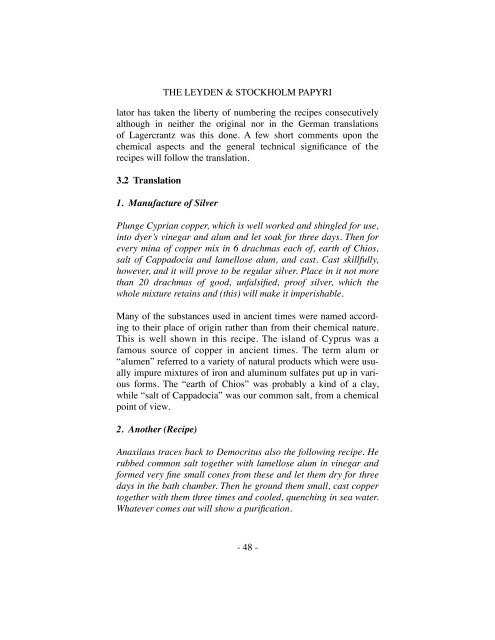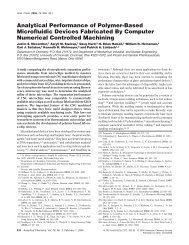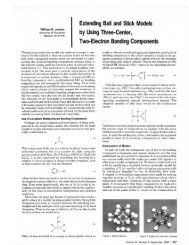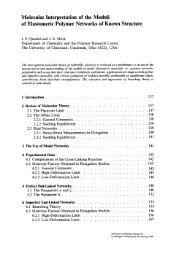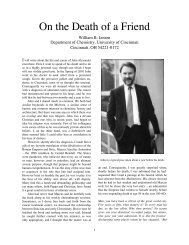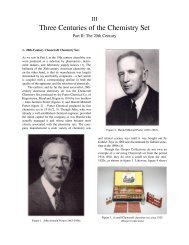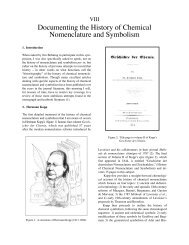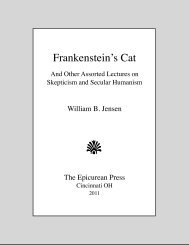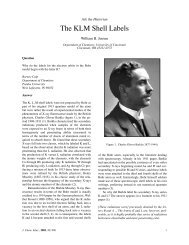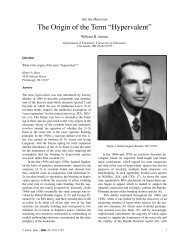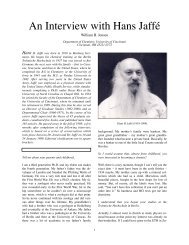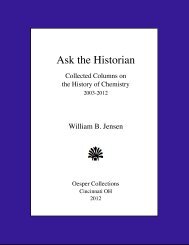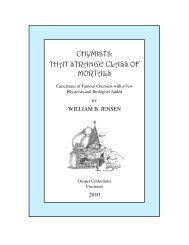The Leyden and Stockholm Papyri - University of Cincinnati
The Leyden and Stockholm Papyri - University of Cincinnati
The Leyden and Stockholm Papyri - University of Cincinnati
You also want an ePaper? Increase the reach of your titles
YUMPU automatically turns print PDFs into web optimized ePapers that Google loves.
lator has taken the liberty <strong>of</strong> numbering the recipes consecutively<br />
although in neither the original nor in the German translations<br />
<strong>of</strong> Lagercrantz was this done. A few short comments upon the<br />
chemical aspects <strong>and</strong> the general technical significance <strong>of</strong> the<br />
recipes will follow the translation.<br />
3.2 Translation<br />
1. Manufacture <strong>of</strong> Silver<br />
Plunge Cyprian copper, which is well worked <strong>and</strong> shingled for use,<br />
into dyer’s vinegar <strong>and</strong> alum <strong>and</strong> let soak for three days. <strong>The</strong>n for<br />
every mina <strong>of</strong> copper mix in 6 drachmas each <strong>of</strong>, earth <strong>of</strong> Chios,<br />
salt <strong>of</strong> Cappadocia <strong>and</strong> lamellose alum, <strong>and</strong> cast. Cast skillfully,<br />
however, <strong>and</strong> it will prove to be regular silver. Place in it not more<br />
than 20 drachmas <strong>of</strong> good, unfalsified, pro<strong>of</strong> silver, which the<br />
whole mixture retains <strong>and</strong> (this) will make it imperishable.<br />
Many <strong>of</strong> the substances used in ancient times were named according<br />
to their place <strong>of</strong> origin rather than from their chemical nature.<br />
This is well shown in this recipe. <strong>The</strong> isl<strong>and</strong> <strong>of</strong> Cyprus was a<br />
famous source <strong>of</strong> copper in ancient times. <strong>The</strong> term alum or<br />
“alumen” referred to a variety <strong>of</strong> natural products which were usually<br />
impure mixtures <strong>of</strong> iron <strong>and</strong> aluminum sulfates put up in various<br />
forms. <strong>The</strong> “earth <strong>of</strong> Chios” was probably a kind <strong>of</strong> a clay,<br />
while “salt <strong>of</strong> Cappadocia” was our common salt, from a chemical<br />
point <strong>of</strong> view.<br />
2. Another (Recipe)<br />
THE LEYDEN & STOCKHOLM PAPYRI<br />
Anaxilaus traces back to Democritus also the following recipe. He<br />
rubbed common salt together with lamellose alum in vinegar <strong>and</strong><br />
formed very fine small cones from these <strong>and</strong> let them dry for three<br />
days in the bath chamber. <strong>The</strong>n he ground them small, cast copper<br />
together with them three times <strong>and</strong> cooled, quenching in sea water.<br />
Whatever comes out will show a purification.<br />
- 48 -


